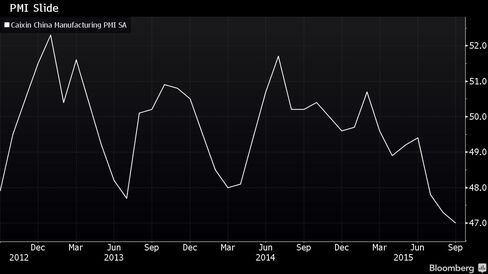A private Chinese manufacturing gauge fell to the lowest in 6 1/2 years, underscoring challenges facing the economy as its old growth engines splutter.
A global sell off in riskier assets gained pace after the preliminary Purchasing Managers’ Index from Caixin Media and Markit Economics dropped to 47.0 in September. That missed the median estimate of 47.5 in a Bloomberg survey and fell from the final reading of 47.3 in the previous month. Readings have remained below 50 since March, indicating contraction.
Premier Li Keqiang’s growth target of about 7 percent for this year is being challenged by a slowdown in manufacturing and exports even as services and consumption show resilience. President Xi Jinping downplayed concern about weakening growth in aspeech in Seattle to mark the start of his U.S. trip, repeating a prior pledge that China can maintain medium to high growth.
Excess capacity “across a number of industries, as well as demand weakness, both domestically and externally, remain the major challenges faced by the manufacturing sectors,” Grace Ng, a greater China economist at JPMorgan Chase & Co. in Hong Kong, wrote in a report. She said the level of supplies of finished products, which rose to the second-highest level in the survey’s history, “points to further drag on industrial activity in the near term.”
The Shanghai Composite Index closed 2.2 percent lower at 3,115.89 while Hong Kong’s Hang Seng Index retreated 2.3 percent. The offshore yuan weakened the most in three weeks, falling to 6.4328 against the U.S. dollar as of 4:35 p.m. in Hong Kong.
The soft PMI "mainly reflected weak external demand," said Julia Wang, a Hong Kong-based economist with HSBC Holdings Plc. "As China has rolled out a slew of pro-growth measures in the past months, China’s domestic demand may have stabilized."
Wang expects more policy support and forecasts another 150 basis point cut in the required reserve ratio for the biggest banks. She said Caixin’s index covers firms with more exposure to exports, and indicators in coming months may show that the economy isn’t as sluggish as the flash PMI indicates.
Readings of output, new orders and employment all declined at a faster rate, according to the survey.

"The new leg down in the manufacturing PMI redoubles pressure on the government to allow market forces to guide the yuan weaker against the dollar before year-end,"William Adams, senior international economist at PNC Financial Services Group, wrote in an e-mail.
Factory Shutdowns
Reflecting the slowdown in China’s old growth drivers, fixed-asset investment rose at the slowest pace in 15 years in the first eight months of 2015 and industrial production trailed analyst estimates last month. Factory shutdowns in Beijing and surrounding provinces before a Sept. 3 military parade in the capital may also have weighed on the manufacturing sector.
For Federal Reserve Chair Janet Yellen, who cited concern over China’s outlook when explaining her decision not to raise interest rates at this month’s policy meeting, more weak numbers could strengthen the case for prudence, Bloomberg economist Tom Orlik wrote in a note.
"The Caixin data doesn’t fundamentally change the narrative, but more weak numbers between now and the Fed’s next meeting at the end of October would obviously add to the case for caution," Orlik wrote.
China’s official factory gauge fell to the lowest reading in three years in August. A measure of services fared better, as the economy’s new growth drivers help cushion the growth outlook. Alternative indicators, such as data culled from China’s most-used search engine, biggest online outlet and main bank-card network, are signaling stabilization in the nation’s economy.
Still, Nomura Holdings Inc. economists say there’s downside risk to their gross domestic product growth estimate of 6.9 percent in the third quarter.
“We continue to expect accommodative monetary policy,” with one more 50 basis point cut of banks’ reserve requirement ratio in the fourth quarter, economists led by Hong Kong-based Yang Zhao wrote. “We maintain our call for fiscal policy to play a larger role in bolstering growth.”
source: Bloomberg
No comments:
Post a Comment